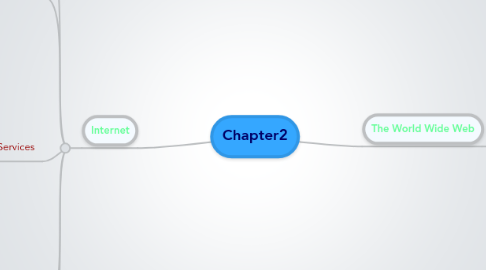
1. Internet
1.1. is a worldwide collection of networks that links millions of businesses, government agencies, educational institutions, and individuals
1.2. Evolution of the Internet
1.2.1. The Internet originated as ARPANET in September 1969 and had two main goals
1.2.1.1. Allow scientists at different physical locations to share information and work together
1.2.1.2. Function even if part of the network were disabled or destroyed by a disaster
1.3. Services
1.3.1. E-mail
1.3.1.1. is the transmission of messages and files via a computer network
1.3.1.2. mailing list
1.3.1.2.1. is a group of e‐mail names and addresses given a single name
1.3.2. Instant messaging (IM)
1.3.2.1. is a real‐time Internet communications service
1.3.2.2. chat
1.3.2.2.1. is a real‐time typed conversation that takes place on a computer
1.3.2.3. chat room
1.3.2.3.1. is a location on an Internet server that permits users to chat with each other
1.3.3. VoIP (Voice over IP)
1.3.3.1. is a location on an Internet server that permits users to chat with each other
1.3.4. Newsgroup
1.3.4.1. is an online area in which users have written discussions about a particular subject
1.3.5. Message board
1.3.5.1. is a Web‐based type of discussion group
1.4. FTP (File Transfer Protocol)
1.4.1. is an Internet standard that permits file uploading and downloading with other computers on the Internet
1.5. Netiquette
1.5.1. is the code of acceptable Internet behavior
2. The World Wide Web
2.1. electronic documents
2.1.1. Web site
2.1.1.1. Home page
2.1.1.1.1. is the first page that a Web site displays
2.1.1.2. Web page
2.1.1.2.1. link
2.1.1.2.2. Web address
2.1.1.3. Download
2.1.1.3.1. is the process of receiving information
2.1.1.4. Web Browser
2.1.1.4.1. Internet Explorer
2.1.1.4.2. Firefox
2.1.1.4.3. Opera
2.1.1.4.4. Safari
2.1.1.4.5. Google Chrome
2.1.1.4.6. Program
2.1.1.5. Type of Web site
2.1.1.5.1. Portal
2.1.1.5.2. News
2.1.1.5.3. Informational
2.1.1.5.4. Business/Marketing
2.1.1.5.5. Blog
2.1.1.5.6. Wiki
2.1.1.5.7. Online Social Network
2.1.1.5.8. Educational
2.1.1.5.9. Entertainment
2.1.1.5.10. Advocacy
2.1.1.5.11. Web Application
2.1.1.5.12. Content Aggregator
2.1.1.5.13. Personal
2.1.1.6. is a collection of related Web pages and associated items
2.1.2. Web server
2.1.2.1. is a computer that delivers requested Web pages to your computer
2.1.3. Web2.0
2.1.3.1. refers to Web sites that provide a means for users to interact
2.2. Type of Search
2.2.1. Search engine
2.2.1.1. Finds information related to a specific topic
2.2.1.2. helpful in locating items
2.2.1.2.1. Images
2.2.1.2.2. Videos
2.2.1.2.3. Audio
2.2.1.2.4. News
2.2.1.2.5. Maps
2.2.1.2.6. People or Businesses
2.2.1.2.7. Blogs
2.2.2. Subject directory
2.2.2.1. Classifies Web pages in an organized set of categories
2.3. Multimedia
2.3.1. graphic
2.3.1.1. is a digital representation of nontext information
2.3.1.2. include
2.3.1.2.1. BMP
2.3.1.2.2. GIF,
2.3.1.2.3. JPEG
2.3.1.2.4. PNG
2.3.1.2.5. TIFF
2.3.2. Animation
2.3.2.1. is the appearance of motion created by displaying a series of still images in sequence
2.3.3. Audio
2.3.4. Video
2.3.4.1. consists of full‐motion images that are played back at various speeds
2.3.5. Virtual reality (VR)
2.3.5.1. is the use of computers to simulate a real or imagined environment that appears as a three‐dimensional space
2.4. E‐commerce
2.4.1. is a business transaction that occurs over an electronic network
2.4.2. Business‐ to‐ consumer (B2C)
2.4.3. Business‐ to‐ business (B2B)
2.4.4. Consumer‐ to‐ consumer (C2C)
